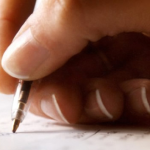Your neck, also called the cervical spine, begins at the base of the skull and contains seven small vertebrae. Incredibly, the cervical spine supports the full weight of the head, which is on average about 12 pounds. While the cervical spine can move your head in nearly every direction, this flexibility makes the neck very susceptible to pain and injury.
The neck’s susceptibility to injury is due in part to biomechanics. Activities and events that affect cervical biomechanics include extended sitting, repetitive movement, accidents, falls and blows to the body or head, normal aging, and every day wear and tear. Neck pain can be very bothersome, and it can have a variety of causes. Here are some of the most typical causes of neck pain: Injury and Accidents; Growing Older (degenerative disorders such as osteoarthritis, spinal stenosis, and degenerative disc disease directly affect the spine); and Daily Life (poor posture, obesity, and weak abdominal muscles often disrupt spinal balance, causing the neck to bend forward to compensate…stress and emotional tension can cause muscles to tighten and contract, resulting in pain and stiffness…postural stress can contribute to chronic neck pain with symptoms extending into the upper back and the arms).
Degenerative Disc Disease can cause reduction in the elasticity and height of intervertebral discs. Over time, a disc may bulge or herniate, causing tingling, numbness, and pain that runs into the arm.
Head and neck posturing with a habitual ‘poking chin’ (cervical protrusion) can result in adaptive shortening of the occipital muscles. It also causes the cervical spine to change alignment resulting in increased stress of the facet joints and posterior discs and other posterior elements. Janda described a cervical ‘Upper Crossed Syndrome’ to show the effect of a ‘poking chin’ posture on the muscles. With this syndrome, the deep neck flexors are weak, as are the rhomboids, serratus anterior, and often the lower trapezius. Opposite these weak muscles are tight pectoralis major and minor, along with upper trapezius and levator scapulae.
A Licensed Physical Therapist after evaluating the neck region and the body globally would use his/her fine-tuned skills to perform any of these varied treatments: Therapeutic Exercises (focusing on strengthening deep neck and pariscapular muscles) and McKenzie repeated movement exercises; Manual Therapy (to include soft tissue massage, joint mobilization/manipulation, and manual traction); Postural /Biomechanics Retrainng; and Modalities (such as mechanical traction, electrical stimulation, and cold laser).





